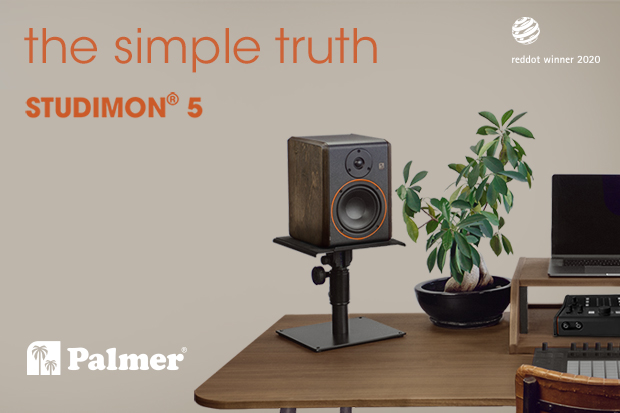Test: Palmer STUDIMON 5
from guest author Daniel Bigaj, infomusic.pl
After a long wait, the nearfield studio monitor by Palmer is finally here. Their official name is STUDIMON 5.

Today, in the age of streaming and podcasting, anyone who produces digital content within the field of audiovisual culture and art should have the right type of equipment. If we’re streaming content, headphones are not the only essential tool – we also need small, easy-to-transport studio monitors. And if we’re sending video and audio data over a network, we’ll need small studio monitors that fulfil their function but don’t exceed our budget. STUDIMON 5 by Palmer is one of the many affordable nearfield studio monitors available on the market. Are they worth it? We’ll find out in a minute.

What can we say about their construction and interior?
Every time I write about Palmer equipment, I mention that it’s a well-known and popular brand, especially when it comes to DI boxes, splitters, press patch boxes and various types of switchers for musicians. Always solidly constructed and always reasonably priced. The price tag never fails to surprise me and I keep expecting their products to be more expensive, although in this hardware range, the prices are similar (with a few exceptions). However, I don’t want to focus on price, but on quality and performance.

When I first take the monitor out of the box (Palmer puts great care and attention into the packaging), I’m impressed by the robust construction. After a thorough inspection (how it was assembled, glued and constructed), I can confirm that Palmer has, once again, delivered the high level of workmanship that we’ve grown to expect from them. A robustly constructed product that is aesthetically pleasing.
Some have probably noticed – I’ve mentioned this when writing about another Palmer product – that the design of their products has changed. If you prefer warmer shades and materials with a pleasant texture, you’ll find them here, as their range is dominated by blacks and browns mixed with orange. Suits me perfectly, but of course this is very subjective. Back to the construction: this studio monitor Loudspeaker has been very carefully assembled and nothing gives the impression that it could come apart in the coming years. In addition, the wooden side panels are very attractive and add to the elegance.

Now that we’ve covered appearance and construction, let’s talk about the interior. This compact nearfield monitor draws on two 30-watt class-AB power amplifiers, and, according to the manufacturer’s description, is fitted with a magnetically shielded 5″ woofer with rubber surrounding, a 0.75″ soft dome tweeter, a 80 mm ferrite magnet and a 28 mm neodymium magnet, plus a rear reflex aperture for optimal deep bass reproduction. The actual speakers haven’t been sourced from some well-known manufacturer; the studio monitor is entirely designed by the engineers at Palmer.

Now to cover other specs, which may be important to some and interesting to others. 2500 Hz bandwidth crossover frequency, with an analogue Linkwitz-Riley 24 dB filter, a dispersion angle (H x V) of 120° x 120°, RMS power of 2 x 30 W, a frequency response of 70–20.000 Hz (−3 dB), a maximum sound pressure level of 110 dBU at 1 kHz (dB), and a signal-to-noise ratio of 85 dB. And everything is protected against short circuiting and overheating. As you can imagine from this description, the performance of these studio monitor monitors loudspeakers seems very promising.
On the rear panel, at the top, there’s a bass reflex, XLR and TRS inputs (connected in parallel, so you can use either XLR or jack), and a volume control and a mains switch. Very minimalistic, perhaps too much so; a simple EQ (HF and LF) would have been useful and expanded our options slightly.

How do they sound?
Now that we know what these monitors have to offer in terms of specs, it’s time to set them up and give them a listen. I’m currently editing the audio for a YouTube production, a kind of instructional video on playing music. Drums, bass, acoustic and electric guitars, synths and vocals. So for today, we’ll change the monitors to Palmer.

I can say that my first impressions are positive. Indeed, as the manufacturer assured, we won’t run out of power. While mixing, I also used a subwoofer. Palmer monitors, like most nearfield monitors, aren’t much good below 70 Hz. However, everything above this works well. If you try them out for yourself, you’ll find that from 70 Hz to 16 kHz, the sound is very even, without any band gaps.

The sound is dynamic (which is certainly due to the speaker design developed by Palmer engineers), very pleasant and clear, with a mid-range that’s not overly exposed. You have the impression that the guitars and snare drum are right there in front of you, and the high frequencies are reproduced quite accurately. The space that features in the mixed material is clearly audible; it’s easy to hear what we did in the Mid and Sides, and how the vocals sound with reverb. And even when we play Mick Gordon productions, they sound good.
After a few hours of working with these monitors, I’m still convinced of their worth: no annoying aspects have been revealed and they offer a neutral sound – neutrality is the most desirable feature when it comes to monitors – and in this respect they won’t disappoint. Everything resonates as it should.

To conclude
STUDIMON 5 is a nearfield monitor manufactured by Palmer, which doesn’t differ in any particular way from other monitors in this price range, but they’re very well made, robust, easy to work with and fulfil their function. They produce a neutral sound and don’t tire the ears, plus they’re attractive to look at (important to some). And when it comes to value for money, there’re probably no others that beat them.
Great, solid workmanship
Excellent value for money
Neutral sound
Just the right amount of power
The Red Dot Design Award – so it wasn’t just me who was impressed… 🙂
They work well with another Palmer product, the Monicon XL (read about our latest TEST)
Even Mick Gordon’s music sounds good on them 😉













